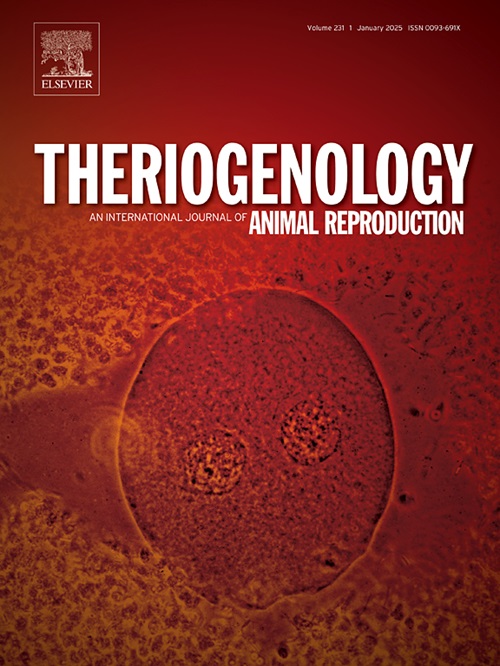Phoenixin-14 and its receptor GPR173 in the bovine endometrium: Expression and regulation during the estrous cycle and impact on secretory activity
IF 2.4
2区 农林科学
Q3 REPRODUCTIVE BIOLOGY
引用次数: 0
Abstract
The endometrium remodels during the estrous cycle due to many endogenous factors. Phoenixin (PNX)-14 is a relatively recently discovered neuropeptide with a pivotal role in reproduction, specifically in follicle development and the functioning of the corpus luteum and uterus. Our study aimed to determine (1) the expression of PNX-14 and G protein-coupled receptor 173 (GPR173) in the bovine endometrium during the estrous cycle, (2) the cellular localization of PNX-14 and GPR173, (3) the effect of luteotropic and luteolytic factors on PNX-14 and GPR173 expression in the endometrium, and (4) the impact of PNX-14 on the secretory activity of the endometrium. The ex vivo experiments used bovine uterine tissues collected from the four stages of the estrous cycle (days 2–5, 6–10, 11–16, and 17–20). The in vitro experiments used uteri collected from days 10–12 of the estrous cycle. The mRNA expression of small integral membrane protein 20 (SMIM20) and protein expression of PNX-14 was upregulated on days 6–10 of the estrous cycle. GRP173 protein expression was significantly higher on days 11–16. The concentration of PNX-14 in endometrial tissue homogenate was significantly lower on days 17–20 compared to all other days of the estrous cycle. In immunofluorescence analysis, luminal and glandular epithelium and endothelial cells of blood vessels were positive for PNX-14 and GPR173. Progesterone upregulated the mRNA expression of SMIM20 in the bovine endometrium, whereas progesterone and oxytocin upregulated GPR173 mRNA and protein expression. Treating endometrial slices with PNX-14 enhanced prostaglandin E2 secretion. In conclusion, these findings indicate that PNX-14 targets the bovine endometrium and should be considered a locally acting regulator of endometrium function in non-pregnant cows.
凤凰素-14及其受体GPR173在牛子宫内膜中的表达调控及对分泌活性的影响
子宫内膜在发情周期内的重塑受多种内源性因素的影响。Phoenixin (PNX)-14是最近发现的一种神经肽,在生殖,特别是卵泡发育和黄体和子宫功能中起着关键作用。我们的研究旨在确定(1)发情周期内PNX-14和G蛋白偶联受体173 (GPR173)在牛子宫内膜中的表达,(2)PNX-14和GPR173的细胞定位,(3)促黄体和溶黄体因子对PNX-14和GPR173在子宫内膜中的表达的影响,以及(4)PNX-14对子宫内膜分泌活性的影响。离体实验采用在发情周期的4个阶段(第2-5天、第6-10天、第11-16天和第17-20天)采集的牛子宫组织。体外实验采用发情周期第10-12天采集的子宫。小积分膜蛋白20 (SMIM20) mRNA表达量和PNX-14蛋白表达量在发情周期第6 ~ 10天上调。GRP173蛋白表达在第11-16天显著升高。在发情周期的第17-20天,子宫内膜匀浆中PNX-14的浓度显著低于其他所有天。免疫荧光分析显示,血管管腔上皮、腺上皮和内皮细胞PNX-14和GPR173阳性。黄体酮上调了牛子宫内膜SMIM20 mRNA的表达,而孕酮和催产素上调了GPR173 mRNA和蛋白的表达。PNX-14治疗子宫内膜片可促进前列腺素E2分泌。综上所述,这些结果表明PNX-14靶向牛子宫内膜,应被认为是非妊娠奶牛子宫内膜功能的局部作用调节剂。
本文章由计算机程序翻译,如有差异,请以英文原文为准。
求助全文
约1分钟内获得全文
求助全文
来源期刊

Theriogenology
农林科学-生殖生物学
CiteScore
5.50
自引率
14.30%
发文量
387
审稿时长
72 days
期刊介绍:
Theriogenology provides an international forum for researchers, clinicians, and industry professionals in animal reproductive biology. This acclaimed journal publishes articles on a wide range of topics in reproductive and developmental biology, of domestic mammal, avian, and aquatic species as well as wild species which are the object of veterinary care in research or conservation programs.
 求助内容:
求助内容: 应助结果提醒方式:
应助结果提醒方式:


